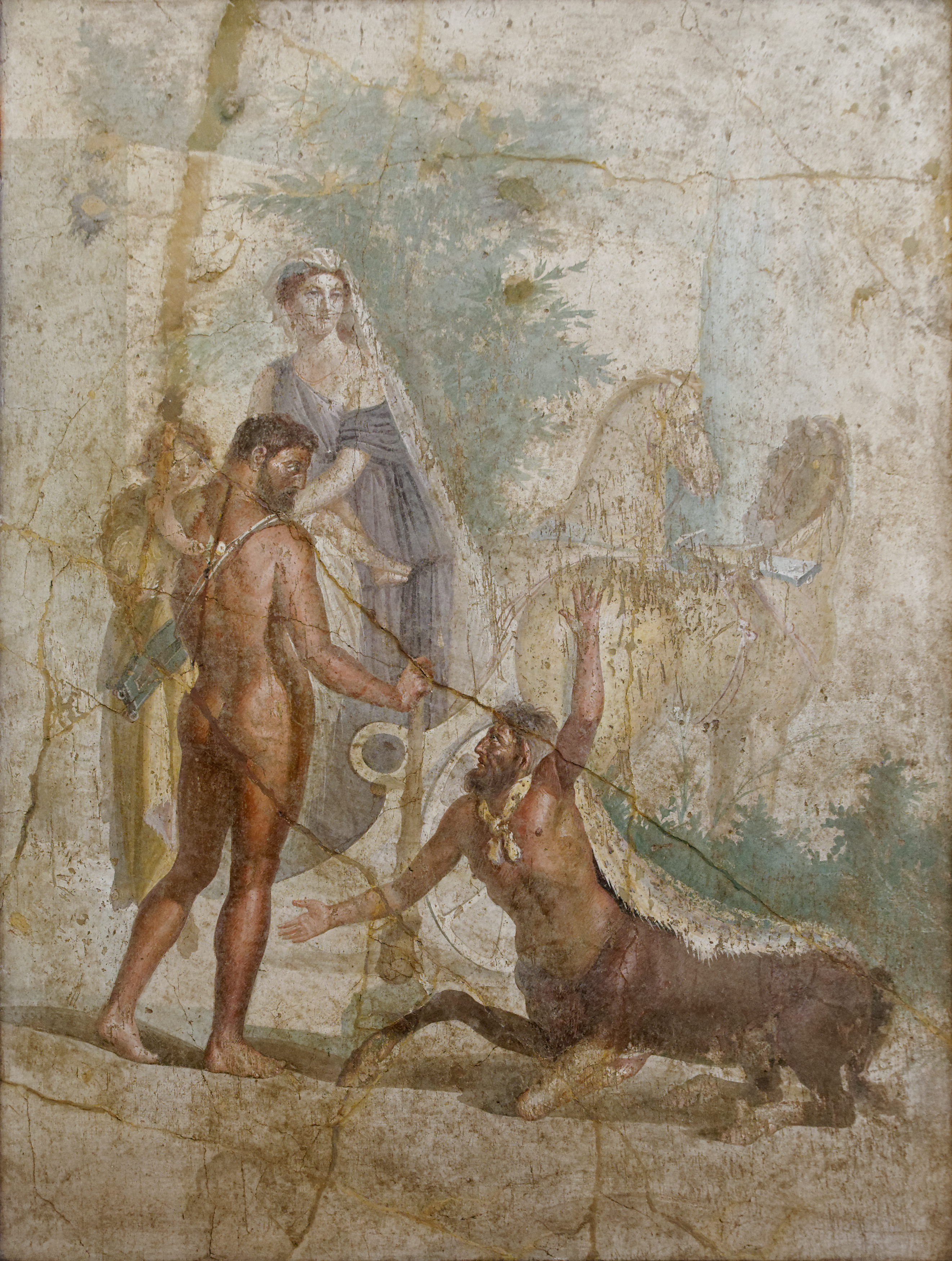Nessus (mythology) on:
[Wikipedia]
[Google]
[Amazon]


 In
In
Little Gidding IV
mirroring the greater theme of the poem.
Nessus and the Death of Hercules
* Perseus Project �
Apollodorus
{{Authority control Individual centaurs Mythology of Heracles


 In
In Greek mythology
Greek mythology is the body of myths originally told by the Ancient Greece, ancient Greeks, and a genre of ancient Greek folklore, today absorbed alongside Roman mythology into the broader designation of classical mythology. These stories conc ...
, Nessus () was a famous centaur
A centaur ( ; ; ), occasionally hippocentaur, also called Ixionidae (), is a creature from Greek mythology with the upper body of a human and the lower body and legs of a horse that was said to live in the mountains of Thessaly. In one version o ...
who was killed by Heracles
Heracles ( ; ), born Alcaeus (, ''Alkaios'') or Alcides (, ''Alkeidēs''), was a Divinity, divine hero in Greek mythology, the son of ZeusApollodorus1.9.16/ref> and Alcmene, and the foster son of Amphitryon.By his adoptive descent through ...
, and whose poisoned blood in turn killed Heracles. He was the son of Centauros. He fought in the battle with the Lapiths and became a ferryman on the river Euenos.
Mythology
Nessus is known for his famous role in the story of the Tunic of Nessus. After carrying Deianeira, the wife of Heracles, across the river, he attempted to have intercourse with her. Heracles saw this from across the river and shot a Hydra-poisoned arrow into Nessus's breast. As he lay dying, as a final act of malice, Nessus told Deianeira that his blood would ensure that Heracles would be true to her forever, knowing the blood to be infected with the hydra's poison. Deianeira foolishly believed him. Later, when her trust began to wane because ofIole
In Greek mythology, Iole (; ) was the daughter of King Eurytus of Oechalia. According to the brief epitome in the ''Bibliotheca (Pseudo-Apollodorus), Bibliotheca'', Eurytus had a beautiful young daughter named Iole who was eligible for marriage ...
, she spread the centaur's blood on a robe and gave it to her husband. Heracles went to a gathering of heroes, where his passion got the better of him. Meanwhile, Deianeira accidentally spilled a portion of the centaur's blood onto the floor. To her horror, it began to fume by the light of the rising sun.
She instantly recognized it as poison and sent her messenger to warn Heracles but it was too late. Heracles lay dying slowly and painfully as the robe burned his skin—either in actual flames or by the heat of poison. He died a noble death on a funeral pyre of oak branches. Heracles was then taken to Mount Olympus
Mount Olympus (, , ) is an extensive massif near the Thermaic Gulf of the Aegean Sea, located on the border between Thessaly and Macedonia (Greece), Macedonia, between the regional units of Larissa (regional unit), Larissa and Pieria (regional ...
by Zeus
Zeus (, ) is the chief deity of the List of Greek deities, Greek pantheon. He is a sky father, sky and thunder god in ancient Greek religion and Greek mythology, mythology, who rules as king of the gods on Mount Olympus.
Zeus is the child ...
and welcomed among the gods for his heroic exploits.
A similar theme appears in certain versions of the story of Medea
In Greek mythology, Medea (; ; ) is the daughter of Aeëtes, King Aeëtes of Colchis. Medea is known in most stories as a sorceress, an accomplished "wiktionary:φαρμακεία, pharmakeía" (medicinal magic), and is often depicted as a high- ...
.
Sophocles
Sophocles ( 497/496 – winter 406/405 BC)Sommerstein (2002), p. 41. was an ancient Greek tragedian known as one of three from whom at least two plays have survived in full. His first plays were written later than, or contemporary with, those ...
' play '' Trachiniae'' (''Women of Trachis'') is extensively based on a retelling of this myth.
Before the Myth
Before the ancient Greeks told the story of Nessus and 'created' centaurs, the Kassites used them as guiding spirits. There may also be a connection to the origin of centaurs in this myth. One etymological explanation for centaur stems from the meaning water-whipper, or water spirit.In popular culture
* InDante Alighieri
Dante Alighieri (; most likely baptized Durante di Alighiero degli Alighieri; – September 14, 1321), widely known mononymously as Dante, was an Italian Italian poetry, poet, writer, and philosopher. His ''Divine Comedy'', originally called ...
's '' Inferno'', Nessus is among the centaurs who patrol the outer rings of the Circle of Violence, making sure those immersed in the Phlegethon don't get out of their position. He was appointed by Chiron to guide Dante and Virgil
Publius Vergilius Maro (; 15 October 70 BC21 September 19 BC), usually called Virgil or Vergil ( ) in English, was an ancient Rome, ancient Roman poet of the Augustan literature (ancient Rome), Augustan period. He composed three of the most fa ...
alongside the Phlegethon.
* The episode is the basis for a section of T.S. Eliot's Four QuartetsLittle Gidding IV
mirroring the greater theme of the poem.
Historical Allusions
The Nessus Shirt story can be connected to real world events and figures of speech. It has been used as an allusion to the early settlers giving infected blankets to Native Americans.References
Bibliography
* F. Diez de Velasco, "Nessos", ''Lexicon Iconographicum Mythologiae Classicae'', Munich-Zurich, Artemis Verlag, vol. VI,1, 1992, 838–847 & VI,2, 1992, 534–555.External links
* Perseus Project �Nessus and the Death of Hercules
* Perseus Project �
Apollodorus
{{Authority control Individual centaurs Mythology of Heracles